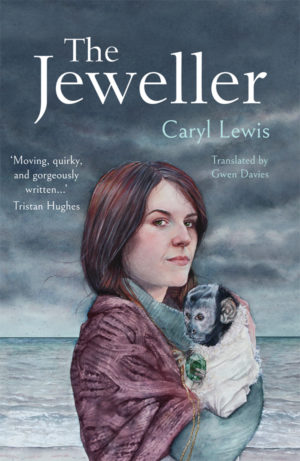Gemma Pearson reviews the much anticipated new novel from prolific Welsh language novelist Caryl Lewis, The Jeweller.
“I don’t believe there are ghosts stalking the earth, but I do think they find a place to live in someone else’s life.”
Have you ever wondered what becomes of our possessions, those objects that carry the memory of a lifetime, when we are no longer here? Having already published eleven novels for adults and been awarded the Wales Book of the Year in 2005, Caryl Lewis’s latest novel, The Jeweller, is hotly anticipated. Translated from the original Welsh by Gwen Davies and published by Honno Press, The Jeweller is a beguiling, quirky story examining the haunting afterlife of the objects we leave behind.
 The novel tells the story of Mari, a market stall holder who surrounds herself with other people’s belongings, combing homes left empty by the death of the occupants for trinkets to sell at her jewellery stall. The short, episodic chapters of The Jeweller facilitate an easy flow of narrative, an ebb and flow that imitates the coastal setting where Mari lives in a remote, seaside cottage in West Wales with her pet cat and a monkey called Nanw. Hoarding the possessions of others to fill a tangible gap in her own life, Mari finds solace in collecting and storing the familial artefacts of strangers, filling her home with other people’s photographs, furniture, and vintage clothes. Despite their affiliation with death, Lewis breathes life into these objects, bestowing them with the power to revive Mari from her frequent periods of self-isolation and introversion.
The novel tells the story of Mari, a market stall holder who surrounds herself with other people’s belongings, combing homes left empty by the death of the occupants for trinkets to sell at her jewellery stall. The short, episodic chapters of The Jeweller facilitate an easy flow of narrative, an ebb and flow that imitates the coastal setting where Mari lives in a remote, seaside cottage in West Wales with her pet cat and a monkey called Nanw. Hoarding the possessions of others to fill a tangible gap in her own life, Mari finds solace in collecting and storing the familial artefacts of strangers, filling her home with other people’s photographs, furniture, and vintage clothes. Despite their affiliation with death, Lewis breathes life into these objects, bestowing them with the power to revive Mari from her frequent periods of self-isolation and introversion.
Mari is particularly enthralled by the prospect of cutting the perfect emerald, having a keen eye for striking, unspoiled gemstones. She is forced to confront the fact that life has no such stone-like solidity, however, when she unearths information about her past that is both transformative and overwhelming. Holding little knowledge about her familial history or where she came from, Mari demonstrates a perceptible sense of longing. Leaning on fellow market stall holder Mo for friendship, and her collected relics for a sense of affinity, Mari attempts to quash such feelings of rootlessness. Nevertheless, not all gaps can be filled, and, as the narrative progresses, it soon becomes clear that it is not only Mari’s house that is cluttered with remnants from times long gone. Her life is also cluttered with debilitating insecurities instigated by unanswered questions about her history. These tantalising twists that threaten to alter the trajectory of Mari’s quiet – albeit unconventional – life render Lewis’s novel something of a page-turner.
In The Jeweller, memory settles like a layer of dust upon an old jewellery box or amidst forgotten archives. The luxuriating prose, in which present-day happenings intertwine with the protagonist’s sentimental musings on the past, shines with palpable veracity that craves retrospection from readers. The recurring intersections between past and present create an insular, almost oneiric atmosphere, reminding readers of the haunting capabilities of memories that refuse to dissipate or die. Lewis’s range of deftly reiterated motifs – including butterflies and the sea – stand as metaphors for this somewhat spectral quality of memory by articulating the fluttering, swelling feeling of haunting that follows Mari throughout the novel. Like dust, memories live with us and alongside us, an (almost) immaterial presence that reminds us of the circularity of existence; what is gone is never truly gone, and what has been lost might come back. Lewis’s narrative, exploring the meaningful afterlife of seemingly inconsequential objects and artefacts, beautifully mediates on this existential condition, offering readers a magical tale of loss, trauma, and self-transformation.
The Jeweller is available from Honno Press.
You might also like…
Carolyn Percy casts a critical eye over a new collection of short stories by Jen Campbell, in her review of The Beginning of the World in the Middle of the Night.
Gemma Pearson is a regular contributor to Wales Arts Review.



 Enjoyed this article? Support our writers directly by buying them a coffee and clicking this link.
Enjoyed this article? Support our writers directly by buying them a coffee and clicking this link.







